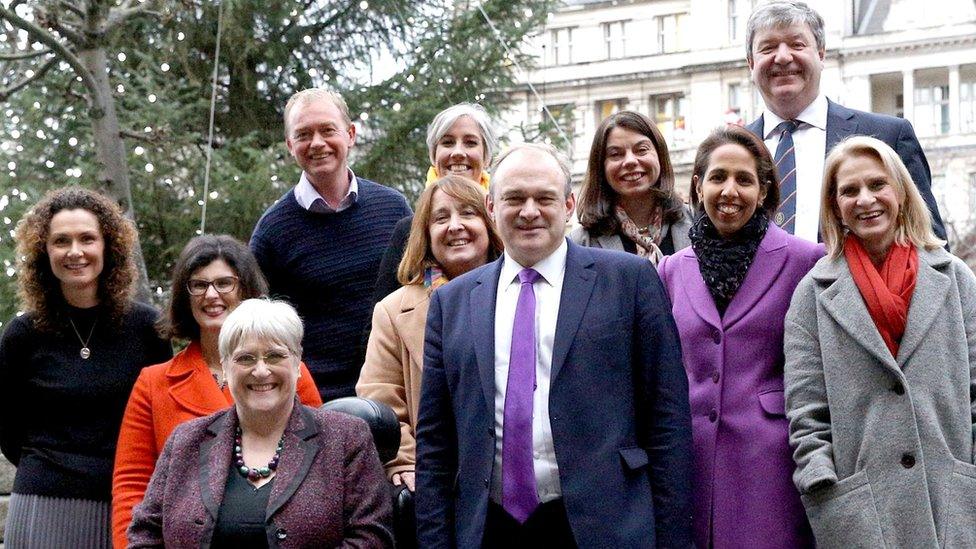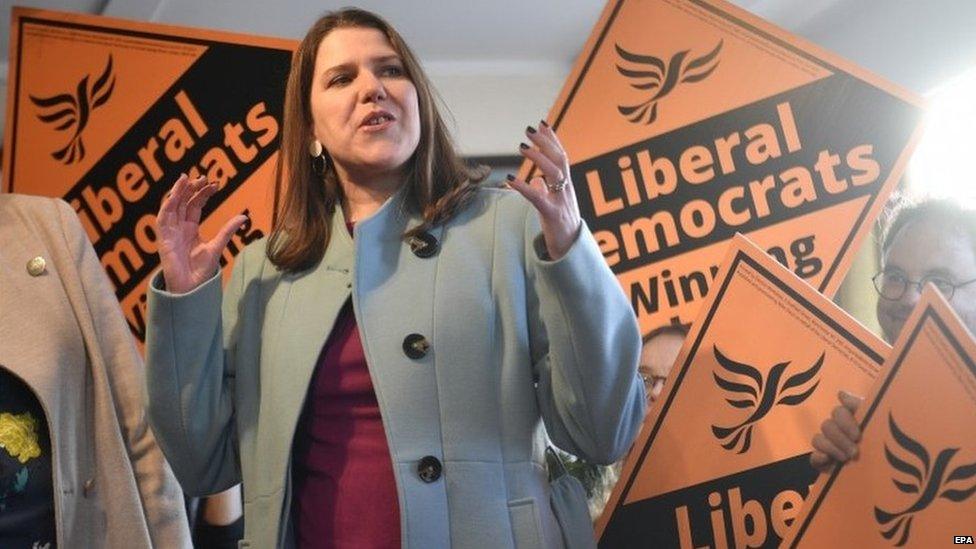Liberal Democrats: Is targeting the 'yellow halo' key to party's success?
- Published
- comments

After the heady days of the coalition, the Lib Dems remain a diminished force in Westminster
The election of a new Liberal Democrat leader in less than a month's time will mark another watershed moment for the party.
The party's 120,000 or so members, who will start voting on Thursday, have a choice between acting leader and former cabinet minister Sir Ed Davey and rising star Layla Moran.
Whoever wins will become the fourth permanent Lib Dem leader in the past five years and take over a party still re-grouping after being chastened at the ballot box for the third election in a row.
After a Stop Brexit election campaign described afterwards by the party as a "car crash", the Lib Dems ended up with 11 MPs in December, one fewer than in 2017, and without a leader after Jo Swinson's defeat.
Despite her best efforts, and those of her predecessors Vince Cable and Tim Farron, the party has yet to truly recover - in electoral terms - from its trouncing in 2015 after five years in government with the Conservatives.
Ms Moran has said it is "sink or swim" time for the party after "10 years of decline" and it needs to restore "trust and credibility" with voters still angry about its record in government as well as its opposition to Brexit.
But Sir Ed, who served as energy secretary under David Cameron, said there were no "quick fixes" for the party and it had to rebuild from the ground up.
A new study by think tank UK in a Changing Europe - entitled What Next For the Lib Dems? - warns that their current electoral position might possibly be as good as it gets for what used to known as the "third party" in British politics.
'Risk of paralysis'
The influential research body says the party's post-2015 levels of representation in the Commons - which excluding defections have ranged from eight to 13 - bear a clear resemblance to those achieved by the old Liberal Party in the 1950s through to the 1970s, and risk becoming the "new normal".
"In short, while they may escape extinction, long-term paralysis looks like a distinct possibility," say the report's authors, Professor Tim Bale, Aron Cheung and Dr Alan Wager.
Ms Swinson's shock defeat in East Dunbartonshire was another painful reminder for the party that - unlike the Conservatives and Labour - it does not have any safe seats in Westminster.

Jo Swinson's brief leadership promised so much but ended in disappointment
But the research also hints at a more promising outlook for the Lib Dems than the headline numbers suggest and grounds for optimism for whoever wins the leadership contest.
As the authors put it, the "new electoral geography of the post-Brexit era" presents opportunities as well as challenges for the party and the makings of a "new electoral coalition" that could bring it future success.
The next leader, it says, has a "genuine opportunity to grow the party once again if they make the right strategic calls".
The party, it says, should draw encouragement from its 2019 result, which showed it had become politically competitive in more places than in 2017 and in new areas of the country as well.
The Lib Dems finished second in 91 seats last year - more than twice as many as in 2017, as the party came from a mile behind to leapfrog Labour in many constituencies.
While the party is nowhere near its 2010 levels of support, when it won more than 30% of the vote in 140 seats, it is within "reasonable touching distance" of winning many more seats next time around.
'Southern party'
Just as significantly, many of those target seats are concentrated in areas of England where the party has struggled in the past.
The old south-west of England heartland built by former leader Paddy Ashdown has been replaced by a new "yellow halo of electoral strength" - stretching from south-west London and eastern Surrey to Oxfordshire, Hampshire and Cambridgeshire.
Both Ed Davey and Layla Moran are based in this area and it includes traditional targets, such as Wimbledon Guildford and Winchester, as well as seats never held by the party, such as Esher and Walton, Woking and Wantage.

Second places "matter" to the Lib Dems, the report stresses
While the Lib Dems remain a force across much of Scotland, which accounts for a third of their Westminster seats, in England they have "clearly become a more southern party" in the past decade, the report says.
The party is struggling to make headway in the big Northern cities and towns like Burnley, Redcar and Rochdale where they once had MPs.
But, on the flip side, this southern bias may help the party to pursue a "core vote" approach at the next election - which some Lib Dem strategists have long believed is the best way to win and retain seats.
Targeting the graduate vote could be crucial, it argues, given the striking correlation between the strength of Lib Dem support and levels of educational attainment in the "yellow halo".
Almost all the party's seats and future targets are in the top 50% in terms of the number of graduates living there, while it either holds or is a close second in 30% of the 64 seats in the top ten of relative graduate numbers.
These voters, the report argues, could potentially propel the Lib Dems to victory in a host of seats next time around, the majority of which are held by the Conservatives.
But this strategy presupposes that this group's dislike of the Conservatives, fuelled by Brexit, and distrust of Labour, exacerbated by Jeremy Corbyn's leadership, remains a decisive factor come the next election in 2024.
Relations with Labour
As Sir Keir Starmer seeks to re-position his party, the old fault line within the Lib Dems about the scope for co-operation with Labour is likely to open up again.
Both leadership candidates have said the Lib Dems must be a "progressive alternative" to the two main parties and retain a distinctive identity, whether over Europe, the environment or identity politics.
Ms Moran said talk of a formal alliance with Labour was premature, while the majority of its MPs were opposed to electoral reform for UK elections.
But she suggested the two parties could work together to maximise the non-Conservative vote at the next election, with Labour campaigning less "vociferously" in seats where her party were the main challengers.

Layla Moran has shown the party how to win a seat from the Conservatives and hold onto it
But the memories of the coalition years mean any attempt to resurrect the Ashdown and Charles Kennedy-era policy of so-called equidistance between the two main parties is likely to prove hard.
And then there are the basic realities of the electoral map.
The report points out that there are just nine seats in the entire country where Lib Dems are the key challengers to Labour, while there are no Lib Dem MPs whose main electoral threat comes from Sir Keir Starmer's party.
While the ingredients are in place for a "symbiotic" relationship with Labour nationally, the report warns too cosy a relationship could lead to a backlash locally, where for many Lib Dem councillors Labour remain the main enemy.
"All politics is local, but...Liberal Democrat politics is more local than most," the report concludes.
"For some of them, the building of some kind of progressive alliance nationally will be far lower down their list of priorities than taking on and beating Labour locally."